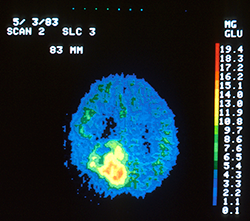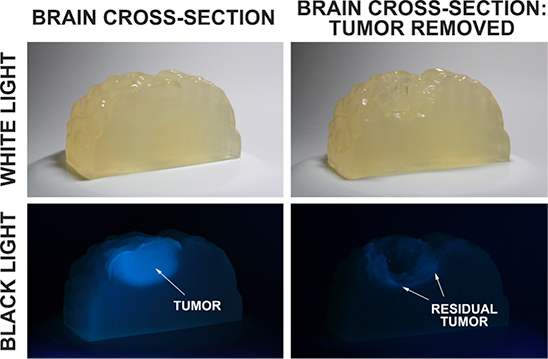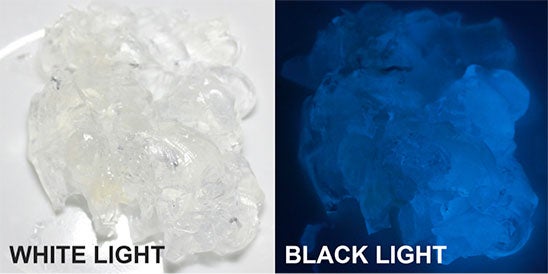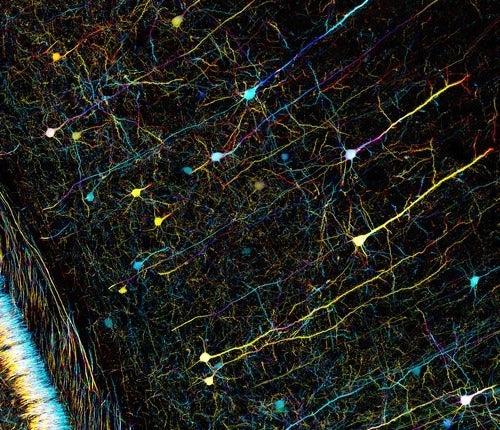Cutting Out Brain Tumors: Teaching Tips
Note: This activity deals with advanced, potentially sensitive topics. We advise it be reserved for students in middle school or higher grades. No matter the age of your students, you may want to check in with them to discuss the topic and make sure everyone is interested in completing the activity before you begin.
In this activity, students will be doing a basic simulation of brain surgery to remove a tumor. Physical removal of a brain tumor is called surgical resection. This is often the main method of treatment for brain tumors. It is important for doctors to be able to tell the difference between tumor and healthy tissue as completeness of tumor removal gives the patient a better chance of survival.
A PET scan (positron emission tomography) of a 62 year old man with a brain tumor. The PET scan displays an increased glucose metabolic rate shown by the irregular bright white area in the center of the scan. Via wikimedia commons.
Recent advances in fluorescent labeling have allowed doctors to improve completeness of tumor removal. Fluorescent dyes absorb light of a particular wavelength and then emit or give off a light of longer wavelength. Fluorescence can be seen during surgery with special optical equipment. Additionally, these dyes can be engineered to accumulate and bind specifically to tumor tissue. Because the dyes are present specifically in the tumor tissue, only the tumor will fluoresce.
For this activity, the tumors will be made of tonic water which contains quinine. The quinine in the tumor absorbs UV light and emits a blue light that can be seen by the human eye. This makes it easier to identify what is tumor and what is healthy tissue. Students will try removing tumors both with and without the help of a black light. Although the tumor will be removed without a black light, the tumor will still contain quinine which will allow students to evaluate completeness of tumor removal after they are finished.
If prep time or funds are lacking, the activity can be modified by using smaller brain molds. Students can also work in groups or can take turns as a class identifying tissue that should be removed.
Overall, this activity provides a fun way to learn about brain anatomy and brain tumors. It can also excite students for a possible future in the medical field.
Brain cross-section under white and black light.
Tips for Classroom Implementation
Time required
Depending on how many brain molds are available to make multiple brains at the same time, it will take between two to eight hours prior to the activity to create all the brains. In class, the activity may take an additional one to two hours.
Estimated costs
- Plastic full brain mold(link is external)*: $10/mold
- Lower cost alternative: Small brain molds(link is external): $5.28/4 molds
- Gelatin(link is external): ~$2.25/brain (found at grocery stores but we recommend buying in bulk from amazon if using larger brains)
- Tonic Water: ~$2 (found at grocery stores)
- Black Light(link is external)**: $5-$10/light
*Whichever mold you end up getting can also be used to create the tumor in advance, trimming it down to a good tumor size before creating the brain.
**The black light used for this activity cannot be a torch/flashlight style light. These produce a light that is too focused/intense and will make the normal brain appear as if it is also fluorescing.
Addional Materials Needed
- Experiement Packet (PDF) [includes worksheets]
Classroom set-up
Have 2-4 students per group and supply each group with the two halves of a brain. The students should work together to remove the tumor. If time permits, have the groups present to the class at the end of the activity. Have them describe what symptoms their patient initially had, and show how much of the tumor they were able to remove. They should also present the parts of the brain the tumor touched.
Resected tumor tissue (gelatin) under white and black light.
In the extension activity, have the students also describe the post-operative scenario and explain what part of the brain they think was injured based off of the patient’s symptoms.
Tips
• Turn off the lights when students are using the black lights in order to increase contrast between healthy and tumor tissue.
Objectives
- Students will learn about the structures and functions of the brain as well as the biology of brain tumors.
- Students will learn about real-world practices in the medical field.
- Students will get to simulate some of the new techniques being used during brain surgery to improve outcomes.
Instructions for Creating the Brain
Recipe yields: 1 brain
Ingredients
- 1 brain mold
- 1 tumor mold (can be created early, in brain mold)
- 56 g of gelatin (8 packets)
- 7 cups water (3 cups hot, 4 cups cold)
- 2 cups tonic water (1 cup hot, 1 cup cold)
- Small amount of vegetable oil
Making the tumor
- Spray or smear the inside of the tumor or brain mold with vegetable oil. Wipe away the excess.
- Slowly add 7 grams (1 packet) of gelatin to a cup of boiling tonic water while stirring to prevent clumping.
- Stir until gelatin is fully dissolved.
- Mix in one cup of cold tonic water (double check this is the tonic water).
- Pour into the tumor mold to fill it.
- Place the mold into the refrigerator until the gelatin is set.
- If you've used the brain mold to make the tumor, cut the set gelatin in fourths, then trim further until it is a good size for a tumor in your brain mold.
*This amount should be enough for two or more tumors depending on the size of the tumor mold
Making the brain
- Spray or smear the inside of the brain mold with vegetable oil. Wipe away the excess.
- Slowly add 49 g (7 packets) of gelatin to 3 cups of boiling water in a separate bowl while stirring.
- Stir until gelatin is fully dissolved.
- Mix in 4 cups of cold water (NOT tonic water).
- Pour the mix into the brain mold
- Allow the gelatin to partially set at room temp for 10-20 minutes
- Take the tumor out of the refrigerator and gently pull on the gelatin to release it from the sides of the mold. Invert the mold onto hand or plate.
- Place the tumor anywhere along the midline of the brain. This is also good if you cut the brain in half, so that tumor tissue will be in both halves. If you need to re-dissolve your gelatin brain a bit, dip the mold (without getting water in it) into a large bowl of hot water. It should loosen up a bit so you can insert the tumor.
- Place the brain in the fridge until the gelatin is set.
- To remove the brain, again gently pull on the gelatin to release it from the sides of the mold. Invert the mold onto a plate.
- Cut the brain in half length-wise with a large knife and store in the refrigerator until needed.
Alternative steps for small brains (yields 4 small brains):
- Slowly add 14 g (2 packets) of gelatin to 1 cup of boiling water in a separate bowl while stirring.
- Stir until gelatin is fully dissolved.
- Mix in 1 cups of cold water (NOT tonic water).
- Distribute the mixture evenly into the four brain molds, leaving some extra room for the tumor.
*We recommend using whole brains rather than half brains if using the smaller mold.
Standards
Common Core Standards
CCSS.ELA-LITERACY.RST.9-10.3. Follow precisely a complex multistep procedure when carrying out experiments, taking measurements, or performing technical tasks, attending to special cases or exceptions defined in the text.
CCSS.ELA-LITERACY.RST.9-10.9. By the end of grade 10, read and comprehend science/technical texts in the grades 9-10 text complexity band independently and proficiently.
Next Generation Science Standards
HS Structure and Function
HS-LS1-2. Develop and use a model to illustrate the hierarchical organization of interacting systems that provide specific functions within multicellular organisms.
View Citation

This activity has a companion article on nerves and the brain. A Nervous Journey takes students on a quick ride from their brain to their toes where they learn about the nervous system and the brain.
Be Part of
Ask A Biologist
By volunteering, or simply sending us feedback on the site. Scientists, teachers, writers, illustrators, and translators are all important to the program. If you are interested in helping with the website we have a Volunteers page to get the process started.








